MARCH
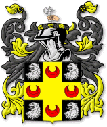 Foreword
Foreword
The surname of March is of Norman origin. The popular translation of the name is Border or Dweller by a boundary. The earliest records submit that the first person with the surname was a French nobleman named Sir William de La'Marche, who in or around 1275, came to England from France. The area of La'Marche was originally situated on the border of Normandy in the Eleventh Century ad, and the English connection stems from the days of the Norman Conquest in 1066.
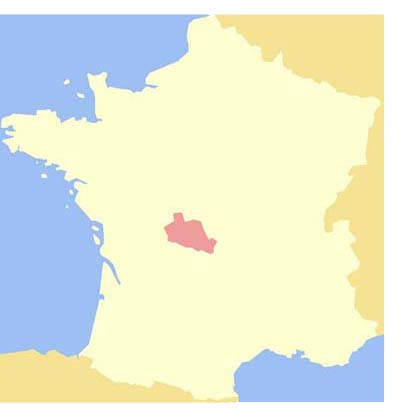 In Norfolk, a town exists called March, which may have been built on the estate, or other land that William may have owned in medieval times. Villages, some which later grew into towns, were sometimes named after the Lord of the Manor, i.e., Tolleshunt Davoy, and
In Norfolk, a town exists called March, which may have been built on the estate, or other land that William may have owned in medieval times. Villages, some which later grew into towns, were sometimes named after the Lord of the Manor, i.e., Tolleshunt Davoy, and
Layer de La Hauve, just to give a couple of examples. According to David Hey's Oxford guide to family history (page 48), the surname of March may be found in the county of Nottinghamshire during 1674.
Left - location of La'Marche
GEORGE MARCH 1763 -1845
In 1662, a plot to murder King Charles 2nd was hatched in Ridley Mill, one mile from Bywell St. Peter. On 22nd March that year, one John Ellerington of Blanchland, opted to report, to the local authorities, about 20 or so men who were plotting the murder, including John March of Ridley Mill. The latter and his colleagues were planning the attack on 25th March but had postponed it in order "to see what Parliament would do, concerning indulgence to tender consciences ". Whether John March is of my family line may yet be proved. For at least 150 years or more, my fore-father's on the March line lived in and around Bywell St. Peter. Bywell St. Peter is a parish comprising of the townships of East Acomb, Apperley, Broomley, Bywell St. Andrew and Peter, Espershields with Millshields, High Fotherley, Healy, Newlands, Newton, Newton Hall, Stelling and the chapelry of Whittonstall. It is bounded by the parishes of Corbridge, Slaley, Ovingham and Shotley, and a part of County Durham, and contains an area of 17,784 acres. In 1801, the population count was 1303 and went up by an average of 100 persons every following census count up until 1851. Part of Bywell was, in the early 19th Century, wild moorland of which 2979 acres were enclosed by an act of Parliament in 1818.
The surname of March can be found in Bywell as early as 1707, but the 1841 Census indicates that George March himself was not born in the county of Northumberland in 1763.However, certain baptism records may suggest that he may have originated from near Slayley, possibly the son of John March and Jane Green but this is uncertain. Also, from records, we find that his wife Elizabeth, actually originated from County Durham, she being baptized in Stanhope on 1st March 1766, possibly the youngest child of six, born to Robert Dawson and Elizabeth James, these two marrying at Stanhope on 1st May 1751.George March married Elizabeth Dawson at the church of Bywell St. Peter on 17th May 1788, this church being where the Bishop of Lindisfarne was consecrated in AD 803. The earliest found March marriage in this church occurred on 30th November 1713 when a certain Abigail March wed Nathan Jewet, but baptism records for the March line can be traced back to 1707. As church records began in this church around 1660, it seems the March families may not have lived in this area until around the turn of the 18th Century. The full list of March marriages at Bywell St. Peter, from 1660 until 1837 are as follows:-

1713 - Abigail March - Nathan Jewet
1720 - Isabel March - James Harrison
1739 - Isabel March - Robert Wood
1772 - Ann March - John Newbiggin
1773 - John March - Isabel Lee
1776 - Jacob March - Hannah Wilson
1778 - Martha March - George Buckham
1782 - William March - Ann Ellison
1788 - George March - Elizabeth Dawson
1809 - Jane March - William Arkley
1810- John March - Mary Phillipson
1811 - Mary March - Edward Hunter
1812- Mary March - Giles Pinckney
Right - Bywell St. Peter, the venue for March weddings and baptisms from 1707
Following their marriage, George and Elizabeth remained in Bywell area living at Eastwood House until the early 1790s, but by 1792 had moved to Rawhouse, situated in Bywell. By 1795, they had moved to Stonecroft near Newbrough. Stonecroft was originally a 13th Century settlement, and lay north-west of Hexham. In the late 1790s, Stonecroft was a tiny hamlet consisting of no more than five houses. Today, all that remains of this hamlet is one house and a farmstead.
Newbrough itself is a chapelry, township, and village, and in 1855 was the property of the Commissioners of Greenwich Hospital, the Duke of Northumberland, Mrs. Wastell, Nicholas Todd Esq., Nicholas Maughan Esq., and the 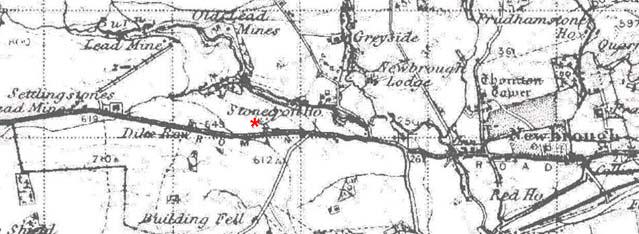 Reverend John Frederick Bigge, each of whom claimed the manorial rights and privileges of his own property. This chapelry accepted Warden as the mother church. There were two extensive lead mines in the chapelry, one situated at Settling Stones, worked by Messrs. Hall, and the other was situated at Stonecroft, carried on under the name of The Stonecroft Lead Mine Company, established in 1851.
Reverend John Frederick Bigge, each of whom claimed the manorial rights and privileges of his own property. This chapelry accepted Warden as the mother church. There were two extensive lead mines in the chapelry, one situated at Settling Stones, worked by Messrs. Hall, and the other was situated at Stonecroft, carried on under the name of The Stonecroft Lead Mine Company, established in 1851.
Right – a 1850s view of the area near Stonecroft
By the late 1790s, George and his family had returned to Rawhouse, moving to Stilford around 1800, but by the early 19th Century, George and Elizabeth had moved to Low Fotherley, which is located today on the A68 main road near Healy. Shortly after that, they moved to Corbridge. Around 1810, they lived at Dilston Park on Corbridge Fell, which 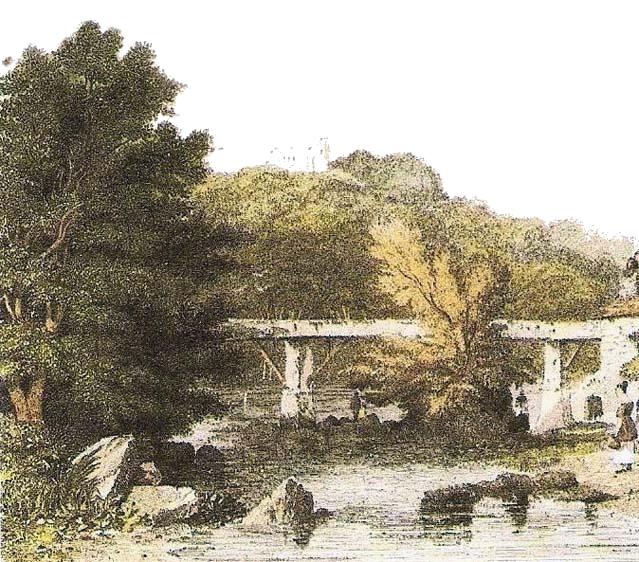 had probably been built on the site of Dilston Hall, a building demolished in 1768. The hall had been built by the Radcliffe Family in the 1620s, but in George March's time there, Dilston was an agricultural area surrounded by a large wooded forest. It was here; in the early two decades of the 19th Century that George probably worked as a Woodman, with his son John March. Corbridge Fell, itself was formerly a south common, enclosed on 13th September 1779 due to a King George 3rd Enclosure Act of 1775, so the fertile area could exploit the most modern agricultural methods.
had probably been built on the site of Dilston Hall, a building demolished in 1768. The hall had been built by the Radcliffe Family in the 1620s, but in George March's time there, Dilston was an agricultural area surrounded by a large wooded forest. It was here; in the early two decades of the 19th Century that George probably worked as a Woodman, with his son John March. Corbridge Fell, itself was formerly a south common, enclosed on 13th September 1779 due to a King George 3rd Enclosure Act of 1775, so the fertile area could exploit the most modern agricultural methods.
Following his time as a Woodman, George mainly worked where he could find employment, but most of the time he was employed as a Labourer. It is thought that this line eventually led to him moving to Newburn, and in June 1841 he and his wife lived near Newburn Farm. Death records indicate that George died in or around Newburn between January and March 1845, while his wife died there between July and September 1847.
Right – how Corbridge fell looked in days of George March
Offspring of George March and Elizabeth Dawson
GEORGE MARCH - was born at Eastwood House near Bywell St. Peter in 1788, being baptized there on 15th April 1789. He lived in and around Corbridge until moving to Hexham during the 1860s. George earned a living as a woodman in his early years, working on Corbridge Fell. On 6th August 1814, at Corbridge, George wed Elizabeth Reed, and approximately five children were born to this union between 1815 and 1824. From at least 6th June 1841 until 1854, George and Elizabeth resided at Dilston Park near Corbridge, and even after Elizabeth's death in 1854, George continued to live in Dilston, being cared for by his daughter Elizabeth, and her husband William Cranston. On 7th April 1861, George lived with the latter at Dilston Park, and in the 1860s moved with them to Hexham where they lived at Dukes House. When Elizabeth and William Cranston moved to South Bedburn in County Durham, it is believed that George went with them, eventually dying in this area in 1878. The offspring of George March and Elizabeth Reed were as follows - Mary March (baptized 13th August 1815), Margaret March (baptized 1817), George March (baptized 1819), John March (baptized 10th June 1821), and Elizabeth March (baptized 4th April 1824).
ROBERT MARCH - was born at Rawhouse, Bywell St. Peter in 1792, being baptized there on 4th March that year. Robert married Mary Pigg on 14th May 1816 and soon afterwards moved to Dewley near Throckley, here he worked as a general labourer. Two offspring were baptised at Newburn on 26th September 1819, named Robert and Ann. During 1827, Robert senior worked as a husbandman living at Chapel House near Newburn, where 3 children were all baptised on 3rd February that year, named John, Elizabeth and George. It is believed that Robert died in the Castle Ward area during 1845.
JOHN MARCH - was born in Rawhouse on 23rd June 1798, being baptized at Bywell St. Peter on 28th October that year. The son of a woodman, John helped his father in that trade, but by the early 19th Century, went in search of work, eventually gaining employment as a Fire-brick maker. He moved to the area of Newburn around 1822 and it was here, in 1826 that John married Jane Burn. The latter was native of this area, and between 1827 and 1848, seven offspring were born there. In the 1850, John and Jane resided in Scotswood, East Denton, which was in the Newburn Parish, and later moved to 'Brick House' in the All Saints area of Newcastle upon Tyne. In the late 1860s, John and Jane were living in Gateshead, residing at 3 Grants Buildings. It is believed that John died in this area during 1878. The offspring of John March and Jane Burn were as follows - Dorothy March (born around 1827), John March (born around 1828), George March (born 1832, and died in 1907), Joseph March (born around 1836), Elizabeth March (born around 1839), Hannah March (born February 1841, and died about 1903), and Mary March (born 1848).
ELIZABETH MARCH - was born on 19th March 1802 at Stilford, being baptised at Bywell on 2nd May that year.At Newburn, on 12th November 1827, Elizabeth wed John Thirlwell, a native of Slaley,
Northumberland, and from this union there were approximately five offspring. In 1826, John and Elizabeth resided in or around Corbridge before settling in the Newburn area from around 1828. Here, John Thirlwell worked as a Carrier before taking up employment as the Landlord of the Half-Moon Public House in Walbottle during the 1850s. John Thirlwell died at Walbottle on 17th November 1862 and was buried at Newburn. By 1871, Elizabeth resided at 31 Mill Lane, Newcastle upon Tyne, where she worked as a provisions dealer. Here she died in 1872.The offspring of John and Elizabeth were as follows – Joseph Thirlwell (born about 1826), John Thirlwell (born about 1828), George Thirlwell (born about 1832), Elizabeth Thirlwell (born 1838, and died in 1842), and William Thirlwell (born 1843).
THOMAS MARCH - Low Fotherley can be located near Healy, Northumberland on the modern-day A68 main road from Corbridge to Darlington and it was at the former that Thomas March was born on 7th January 1805, being baptized at Bywell St. Peter on 17th March that year. Thomas spent all his life in Northumberland and died in the Castle Ward district in 1879. On 15th November 1825, he wed Ann Stobbart at St. Michael's Church in Warden and set up home at Corbridge from 1826 until around 1842. Ann died in this year and Thomas then went to live in Walbottle, where he is recorded in the 1870s. Ann herself, had been born at Haydon Bridge on 24th November 1800, but in 1802, had moved with her parents to Newbrough. In 1805 she moved to Wark, Northumberland before residing in Warden. On 6th June 1841, Thomas and Ann lived at Main-street in Corbridge and it was here that Ann died. There were approximately 9 children born to Thomas and Ann, but in January 1842 the weather in Corbridge was harsh and the cold climate took its toll on Thomas' family, claiming the lives of not only Ann, but also 3 of their children in a short space of time. During 1861, Thomas was living with his son George at 'Gate House' in Throckley where both were employed on the local farms as Husbandmen, and around the end of this decade, Thomas and George had both moved to Blucher Pit near Walbottle, where the latter worked at that time. The offspring to Thomas and Ann were as follows - Margaret March (born 1826), Mary March (born 1826), George March (born 1829), Elizabeth March (born 1831 and died 1904), Thomas March (born 1833), Matthew March (born 1834 and died 1871), Mary March (born 1836 and died 1842), Ann March (born 1839 and died 1842), and, Robert March (born 1841and died 1842).
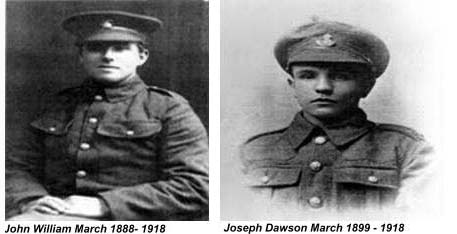 JOSEPH MARCH - was born on 4th November 1807 near Dilston, he being baptized at St. Andrew's Church in Corbridge on 27th March 1808. Around 1830, Joseph went to work in Winlaton near Gateshead. The history of Winlaton is quite colourful, and the northern part of the village was a coal mining centre from the 14th Century onwards. The current village was linked with Blaydon itself by well designed modern housing estates whose hillside roads look across the broad Tyne Vale to Newburn. An 1870 view describes the village as a parish, a township, and a sub-district of Gateshead, which stood one and a quarter miles SSW of Blaydon Railway Station, and thick in extensive ironworks. On 27th July 1834, in St. John's Parish, Newcastle upon Tyne, Joseph married his sweetheart, Elizabeth. McOlvin, she living from 1809 - 1888. Joseph's untimely death occurred in 1855 in the Gateshead area, but,.Winlaton has been the home of Joseph and Elizabeth's descendants from 1836 until at least 1951. The offspring to the latter were named as follows - Elizabeth March (born 1836), John March (born 1838 and died about 1856), Robert March (born 1840 and died 1918), George March (born 1843 and died 1914), Joseph Dawson March (born 1848 and died 1879), Mary Ann March (born 1851), and, William March (born 1854 and died 1923).
JOSEPH MARCH - was born on 4th November 1807 near Dilston, he being baptized at St. Andrew's Church in Corbridge on 27th March 1808. Around 1830, Joseph went to work in Winlaton near Gateshead. The history of Winlaton is quite colourful, and the northern part of the village was a coal mining centre from the 14th Century onwards. The current village was linked with Blaydon itself by well designed modern housing estates whose hillside roads look across the broad Tyne Vale to Newburn. An 1870 view describes the village as a parish, a township, and a sub-district of Gateshead, which stood one and a quarter miles SSW of Blaydon Railway Station, and thick in extensive ironworks. On 27th July 1834, in St. John's Parish, Newcastle upon Tyne, Joseph married his sweetheart, Elizabeth. McOlvin, she living from 1809 - 1888. Joseph's untimely death occurred in 1855 in the Gateshead area, but,.Winlaton has been the home of Joseph and Elizabeth's descendants from 1836 until at least 1951. The offspring to the latter were named as follows - Elizabeth March (born 1836), John March (born 1838 and died about 1856), Robert March (born 1840 and died 1918), George March (born 1843 and died 1914), Joseph Dawson March (born 1848 and died 1879), Mary Ann March (born 1851), and, William March (born 1854 and died 1923).
WILLIAM MARCH 1795 - 1879
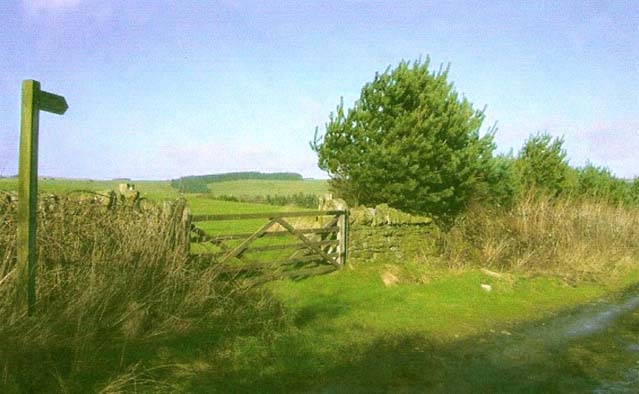 Stonecroft was originally a 13 Century settlement and in the year 1325ad it was a small hamlet, while in medieval times, Hexham Priory held land there. What remains of Stonecroft today, lies north-west of Hexham, near Newbrough. In the 18th Century, the village consisted of just five houses and by 1844 only two of those houses remained. Today, there is one house and a farmstead.
Stonecroft was originally a 13 Century settlement and in the year 1325ad it was a small hamlet, while in medieval times, Hexham Priory held land there. What remains of Stonecroft today, lies north-west of Hexham, near Newbrough. In the 18th Century, the village consisted of just five houses and by 1844 only two of those houses remained. Today, there is one house and a farmstead.
Right – a 21st Century view of Stonecroft
William March originated from Stonecroft and was baptized in Newbrough on 2nd August 1795, one of seven found children born to George and Elizabeth March. As a child, William and his family moved around quite a bit, mainly due to his father's employment as a Woodman, having to go where the work was available. In the early 1800s, they had moved from Stonecroft and settled in Low Fotherley, and by 1807, they lived in Corbridge. When William was a youngster, growing up in the Corbridge and Hexham district, the area was a mixture of farms and isolated buildings, scattered here and there. Because of this, it is suggested that William's occupation, in the main, may have been based around the farming trade, and certainly, in 1851 he was recorded as an agricultural labourer. Ten years previous, he was employed as a courier in Swalwell. At some point in 1853, William also worked as a glass maker. The full list of occupations that William undertook are recorded as such:-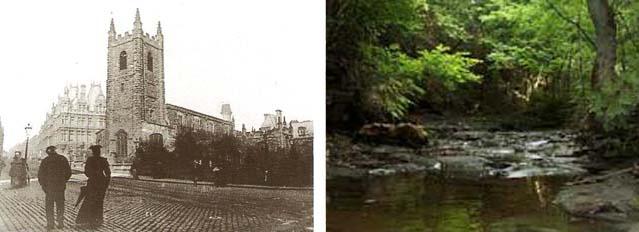
1822 - 1825 - labourer
1830 - 1833 -Husbandman
1834 - Clay grinder
1836 - fire-brick maker
1838 - 1840 - Labourer
1841 - Courier
1842 - Husbandman 1845 - Labourer
1851 - Agricultural Labourer
1853 - Glassmaker
1861 - Labourer
1879 - Brick-maker's Labourer
Right – (left) - St. John's Church, Newcastle upon Tyne, where William and Mary wed on 26th March 1822. Above (right) - Throckley and Walbottle Dene.
It is not certain how long William March was associated with Stonecroft and the Newbrough district, but at some point around 1820 he was linked to Wickham or Newcastle upon Tyne. His wife, Mary Thompson, whom William wed at Newcastle upon Tyne on 26th March 1822, was born in the parish of Whickham, at Swalwell in 1802. The general consensus is that, following their wedding, William and Mary had moved to the Walbottle, and certain censuses would suggest that they lived near Dewley Burn, also referred to as Throckley Dene. In 1822, William and Mary lived at Dewley, but by 1825 had moved to Throckley Red Row.
The church of St Michael and All Angel in nearby Newburn was the venue for the baptisms of at least four of William and Mary's offspring from 1822 until 1828, but after that latter year, the family had moved to Swalwell, living here until around 1850, but, from 1833 until May 1836, lived at Burnt Houses in Winlaton before returning to Swalwell, where in the 1840s they resided at Hoppers Buildings. It was while living in Swalwell that the deaths of at least four of their children occurred between September 1839 and November 1846. All four were buried in St. Mary's Church in Whickham.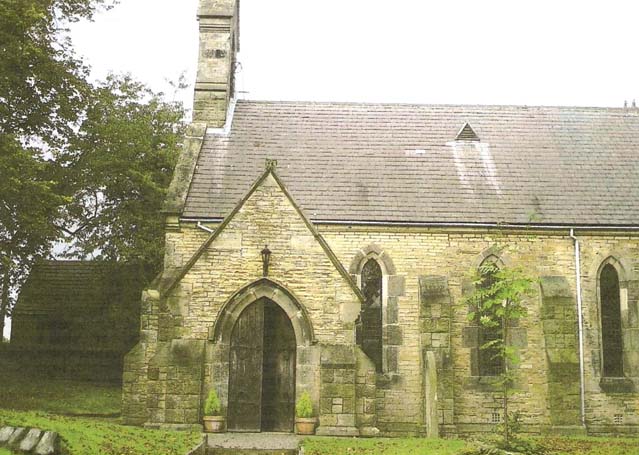
Around 1850, the March family moved to the district of Auckland in Durham, and set up home at Howden in North Bedburn where William was employed on the local farms as a labourer. By the turn of the 1860s William and Mary had moved to Crook and Billy Row, where two addresses are recorded for North Terrace and Commercial Street. In the mid 1870s, William and Mary moved to Old Hunwick near Willington. It was here that William passed away on 20 April 1879, his wife having died three years previous. William March was buried in the village churchyard in an unmarked grave on 23rd April 1879.
Right – St. Paul's Church at Hunwick)
The offspring of William March and Mary Thompson
ISABELLA MARCH was baptized in St. Michael and All Angel Church in Newburn on 24 November 1822, and is thought to have died before 1841.
JANE MARCH was born at Throckley in 1825, being baptized in St. Michael's, Newburn on 2nd September 1825. Jane possibly died before 1841.
ELIZABETH MARCH was baptised the same day as the above Jane.
ANN MARCH was born in Swalwell in 1830, being baptized at Whickham on 5th December that year. Ann shows up at the family home in 1841, but after that, there are no further details.
THOMAS MARCH was baptised at Winlaton on 5th May 1833, being born around 26th April that year. He was buried in St. Paul’s, Winlaton on 8th July 1833.
ISABELLA MARCH was born about 27th October 1834 at Winlaton, but died there in February 1835.
SARAH MARCH was baptized at Winlaton, Gateshead, on 15th May 1836. She died at Swalwell in September 1839, being buried at Whickham on 11th September that year.
THOMAS MARCH was born during 1838 at Swalwell. He was baptized at Whickham on 26th September 1838. In 1851, he worked as a brick maker's labourer, and married Ann Taylor in 1861 in the Auckland district of County Durham. From 1864 until 1870, Thomas and Ann lived in Crook, and it was here that the births of John Taylor March (1864), Anne March (1866), Jane March (1868) and Elizabeth March (1870) took place. By 1872, the family had moved to nearby Hunwick. The births of Sarah March (1872), Alice March (1874), William March (1878) and Ellen March (1880) all took place here. While still living in Hunwick during 1881, Thomas worked as a brick maker, believed to be at Roddymoor. John Taylor March also worked at the brick factory as a general labourer. Thomas and Ann still lived in Hunwick in 1901, and Thomas died here in 1906, followed by his wife in 1918.
GEORGE MARCH was born in Swalwell during May 1841, being baptized at Whickham on 17th May that year. Sadly, aged 5 months, he died at Swalwell and was buried at Whickham St. Mary's on 26th September 1841.
GEORGE MARCH named out of respect to his brother, the former was born in Swalwell during July 1842, being baptized at Whickham on 21st August that year. At the age of 7 weeks old, George died in Swalwell and was buried in Whickham St. Mary's on 1st September 1842.
MARY MARCH was born in Swalwell in 1845, being baptized at Whickham on 28th July that year. She died in 1846 and was buried at Whickham St. Mary's on 1st December that year.
MARY MARCH was born in Swalwell in 1848, being baptized at Whickham on 1st October that year. She married Thomas Nevin Heslop on 17th December 1870 in the Auckland district, he being the son of Nevin Heslop and Jane Robinson. In 1871, Thomas and Mary lived with the latter's parent's in Commercial Street, Crook. They are recorded in the Auckland district from at least 1871 until 1893, and following their marriage, appear to have moved to Howden-le-Wear, before moving to Fylands Bridge. In 1879, Mary and Thomas were living in Etherley and in 1881, lived at 4 Rail Street, North Bedburn. By 1882, they lived back in Howden-le-Wear. In the mid 1880s, Thomas and Mary lived at Greenhead before moving to Low Beechburn and then, once again, back to Howden-le-Wear around 1891. They still lived here prior to World War One. Thomas died in this area in 1917 aged 71, with Mary passing away in 1931. Their 13 children are listed as so: -
Nevin Heslop - 1871 - 1871
Jane Heslop - 1872 -
Nevin Heslop - 1873 - 1875
William Heslop - 1875 - 1954
Lucy Heslop - 1876 - 1927
Thomas Nevin Heslop - 1879-
Emma Heslop - 1882 -
Annie Heslop - 1882 -
Frederick Nevin Heslop - 1883 - 1957
Mary Heslop - 1884 -
Francis Philipson Heslop - 1886 - cl947
Sarah Isabel Heslop - 1890 -
Lydia Heslop - 1893 -
WILLIAM MARCH 1828 -1904
Walbottle Dene and Throckley Dene is a stretch of semi-natural ancient woodland near the western border of the city of Newcastle upon Tyne. It is a steep side wooded valley with the Dewley Burn, a stream, running through it and eventually down to the River Tyne. The area is listed in the Ancient Woodland Inventory, drawn up in the 1600s and would have been part of the wild woods that covered the countryside. It has most likely remained untouched since the ice age of 10,000 years ago. The population for Walbottle, in the 1820s was around 680, while Throckley, at this period was about 190.
This was the area that William March was born in during 1828, one of ten children born to a Husbandman,
William 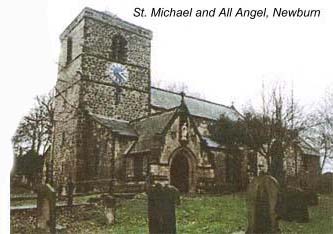 March and his wife Mary. The Census' of 1891 and 1901 list young William's birthplace as Throckley, while the 1871 and 1881 Census, state Walbottle as the place of birth. The Census of 1851 and 1861, claim Barrasford to be his birthplace. It seems more likely that William was not actually aware of his place of birth and therefore, in later years, presumed it was Throckley, due to him being baptized at Newburn. From records, it is shown that his parents had been living in this area since at least 1822 and in 1828, lived at New-building.
March and his wife Mary. The Census' of 1891 and 1901 list young William's birthplace as Throckley, while the 1871 and 1881 Census, state Walbottle as the place of birth. The Census of 1851 and 1861, claim Barrasford to be his birthplace. It seems more likely that William was not actually aware of his place of birth and therefore, in later years, presumed it was Throckley, due to him being baptized at Newburn. From records, it is shown that his parents had been living in this area since at least 1822 and in 1828, lived at New-building.
William himself was baptised in the Church of St. Michael and all Angel in Newburn on the 20th July 1828, one of six baptisms that day. The baptism registers for Newburn also show a certain John Thirlwell being baptised on the 20th July the latter being a cousin of William.
Newburn, in the 1820s was on the verge of becoming quite an industrial area. An 1868 reference to the area states that the parish of Newburn was chiefly in the West division of Castle Ward and stretched along the North bank of the Tyne. At the time Newburn consisted of steel works, coal-staiths, iron foundries, chemical works, a paper mill, brick and tile manufactures and glass works.
As a child, William's family moved from the Walbottle area and set up home in Swalwell, and during the 1840s, their address is given as Hoppers Buildings. William is given mention here in 1841 but by the end of the decade, had moved to Berry Edge, later renamed Consett. He had found employment as a brick maker which was to be his trade from around the mid 1840s until he took to coal mining in the 1860s.
It is not exactly clear where William may have lived at Berry edge, as the 1851 Census lists him as a visitor to the home of Matthew and Elizabeth Dobson of 217 Berry Edge. The latter probably once lay near the modern site of the old Consett steel works, as back in 1851, the Census indicates that there were iron workers living nearby.
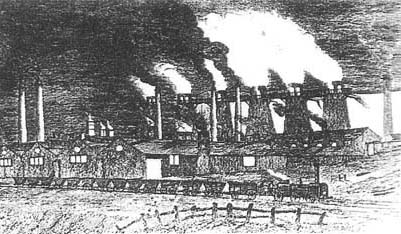
Right – An 1851 view of Berry Edge.
It is known that sometime just after the 1851 Census came out; William went to live at Hart Bushes, in the sub-district of Monk Hesledon, where he worked as a brick maker for South Wingate Colliery. This area contained three collieries, these being Castle Eden (1840 - 1893), Hutton Henry (1869 - 1897), and South Wingate (1840 - 1857), the latter also being known as Rodridge or Hart Bushes. Today, Monk Hesledon is a small village leading from the Castle Eden to Blackhall road. It was at the parish church of Monk Hesledon, on 18th July 1853 that William married Jane Harrison, and shortly after that they moved to Billy Row in Crook.
Jane was born at St Peter's Quay, Newcastle upon Tyne in 1836, and the daughter of Mark Harrison.
She was baptized at the All Saints Church in the city on 6th February 1837, and in 1841, Mark and his family lived in Byker. Jane's mother, Ann Sarah (Charlton) is thought to have died around 1838, leaving Mark to bring up Jane and her sister Ann. By 1851, Mark was probably living in the district of Stockton.
In 1856, William and Jane were living not far from Newcastle, at Willington Quay, and it was here, their eldest son, William was born on 9th April that year. However, he was not baptized until 1860, apparently in Bishop Auckland.
It was around 1859 when the March family went to live in Crook for the second time, residing at South Street. In crook, William senior worked in or around Roddymoor, at the brick making factory which had been built in 1860 by the firm of Pease & Partners, who also owned different coal mines at Crook in the mid 1800s.
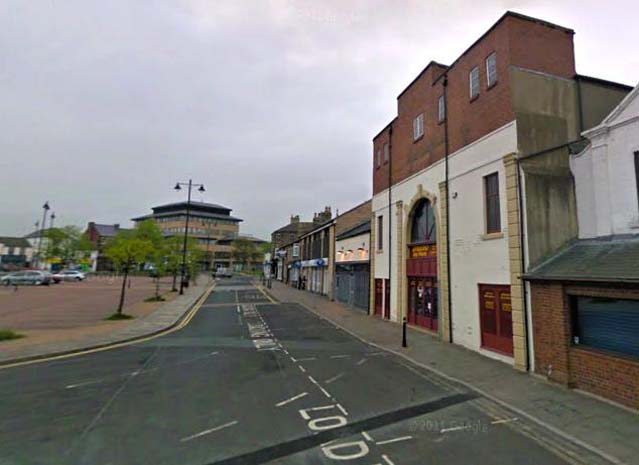
Right – the site of the original South Street in Crook
Crook was the birthplace of William and Jane's daughters, Sarah and Mary Ann, born there in 1855 and 1860 respectively. Both were baptized the same day at Crook, on 3rd April 1861. The Census for that year shows William and Jane sharing their home with two lodgers named Edward Charlton and William Harrison, and an open mind should be kept due to both these surnames featuring heavily in Jane's ancestral family line. The March family was still living in Crook when my great-grandfather, George March was born in June 1862, but by 1864, the family had moved to Bishop Auckland.
It was in the latter town that the birth of Thomas March took place in 1864, but William and Jane later moved to Washington, where William was most likely employed at Usworth Colliery which had opened between 1845 and 1847. Here, at Usworth, the births of Mark and Mary Agnes March occurred between 1867 and Christmas Day 1869. The latter had been named after her elder sister, Mary Ann, who sadly died in 1868. Mark himself died as a youngster in October 1872 at Urpeth and was buried in Pelton Holy Trinity Churchyard on 18th October that year, aged just 5 years old.
Between 1870 and 1871, the March family moved to Urpeth Colliery. Here William was employed at the recently opened D Pit which had been sunk in 1865. This colliery was also known as Low Urpeth Colliery (1835-1957)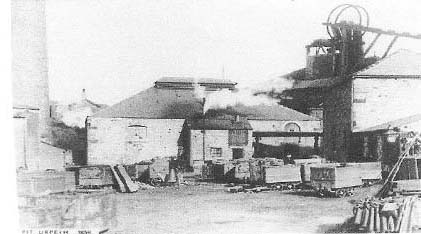
Right – Urpeth Colliery.
From 1873 until 1881, the March family was living in the parish of Holmside, where in that latter year; they occupied a colliery house at 4 Double Row in Holmside. It was at Holmside that William and Jane's two youngest children were born in 1876 and 1878 respectively. Holmside Village was developed late in the 19th Century and was inhabited mainly by coal miners who worked at the collieries of Edmondsley, Sacriston and Craghead. The latter was often called Holmside Colliery. Holmside did not have its own church, and the latter actually lay 2 miles to the west at Burnhope, being built there as late as 1869. Prior to that year, baptisms, etc., were held at Lanchester. The area of Holmside was first given mention in 1214 as Holneside, from the Old English name Holeyn, meaning Holly tree slope. The village in William's time there was situated around the Wardles Bridge Inn.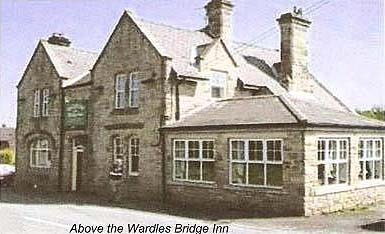
In the 1880s, William and Jane had moved to Craghead Village itself, eventually settling at 11 William Street, and was here that Jane was thought to pass away during 1892. She was buried in an unmarked grave in Pelton Churchyard on 7th February that year aged 55.
(Grave number OA163).
Ten years previous, in 1882, William March was recorded as a Labourer, but by the turn of the 20th Century had retired.
Following Jane's death, he went to live at 2 Tempest Terrace in Stanley, the home of his daughter Jane, and her husband Philip Muncaster. Here, William lived in the upstairs room of the two storey house, while the rest of the property was occupied by Philip, Jane, and their two children, Mary and John Willie Muncaster.
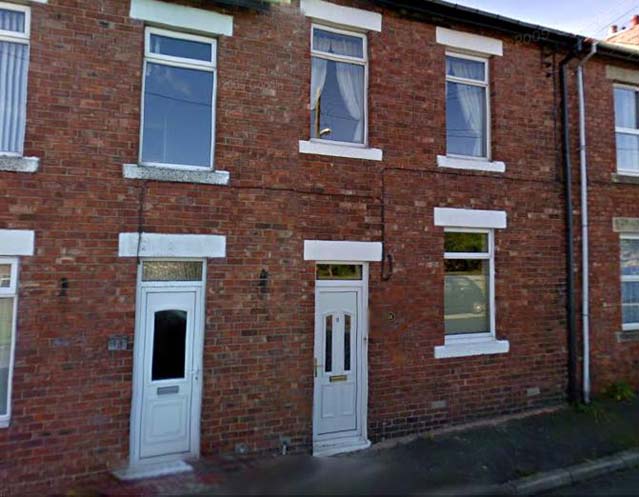
Right – 11 William Street, Craghead, as it is today. Jane March is believed to have died here in February 1892.
Around 1902, William left Tempest Terrace and moved to Barbers Buildings, not far from the Charlaw Inn at Blackhouse. These buildings, now long gone, were set alongside Beechgrove Terrace. It was here that William March died on 20th October 1904 due to a build-up of excess fluid to the body cavities (Dropsy). He was buried in an unmarked, single grave in the same churchyard as his wife, on 24th October. (Grave number OF 174).
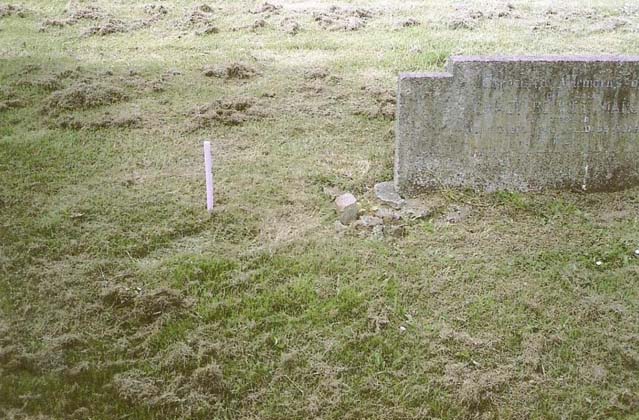
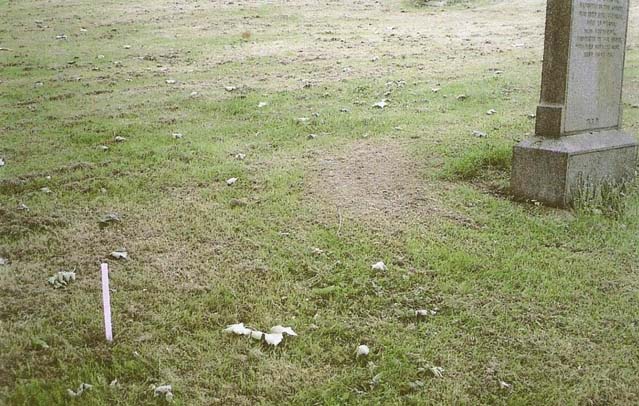
Above Left – The grave of William March, Right The grave of Jane March (shown with white markers)
MARY ANN MARCH was born in Crook, County Durham during 1855, but was not baptized until 3r April 1861, thought to have taken place at Crook Methodist chapel, which had been built in 1860. Mary Ann died at Usworth in 1868, aged just 13.
SARAH MARCH was presumably named after her grandmother on her mother's side of the family. She was born during 1859 at Billy Row, Crook, but was not baptized, like her elder sister Mary Ann, until 3r April 1861. In 1877, Sarah married Matthew Gardiner in County Durham, he being born in West Auckland in 1854. In the 1880s, Sarah and Matthew lived at 16 Double Row in Holmside, later moving to nearby Craghead village. Their eldest two children, William and Agnes Ann March were both born in Holmside in 1878 and 1880 respectively, but their remaining ten offspring were all born in Craghead between 1886 and 1910. Sarah and Matthew lived in Craghead for at least 25 years and probably beyond, as they both died in the Lanchester district. Sarah passed away on 22nd November 1925, followed in 1932, by Matthew.
MARK MARCH was named after his grandfather on his mother's side of the family. Mark was born at Usworth in 1867, being baptized there on 28th September 1868. Sadly, Mark died in October 1872 at Urpeth Colliery, aged just 5 years old. He was buried in Pelton Holy Trinity Churchyard on 18th October 1872.
JANE MARCH was named after her mother, being born at Urpeth Colliery during 1872. Jane was baptized in Urpeth on 1st September 1872 and in 1896 she married Haswell born Philip Muncaster. In 1901, these two lived at 2 Tempest Terrace in Stanley. They shared two children, Mary and John Willie Muncaster, both born in Stanley in 1900 and 1898 respectively. Jane died on 27th July 1943 and was buried in a single, unmarked grave (Number C342) in Pelton churchyard. Philip died on 17 September 1957 and, likewise, was buried at Pelton in a single, unmarked grave (Number B73) on 22nd September, aged 84.
JOHN MARCH was born at Holmside on 2nd September 1876. He earned a living as a coal miner and lived with his parents, and then his widowed father, until John married in 1899. This marriage appears to have taken place in the district of Easington. John's wife, Mary Holliday, originated from Stanley and following their marriage, returned to this area, living at Meldon Terrace, Annfield Plain. They shared four daughters, all born in Stanley between 1901 and 1915, and in 1911, lived at 17 Tempest Terrace, Stanley. At this time, John worked as a Deputy Overman. John is thought to have died around 1933.
ELIZABETH ANN MARCH was born at Holmside on 14th September 1878. By 1900, Elizabeth was working as a domestic servant at George Street in Craghead, the home of Colliery Mechanical Engineer Charles Crofton. Elizabeth is believed to have died in November 1924.
CONTINUED on W. MARCH 1856